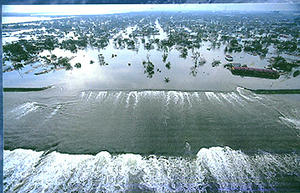New levee design, construction materials tested in Louisiana
Since Katrina, attention has been riveted on $14 billion worth of federal projects to rebuild the deficient hurricane levee system so it can better defend from surges out of lakes Borgne and Pontchartrain; the Army Corps of Engineers plans to start experimenting with a new construction method, which relies on a mix of lime and clay to build the test levee higher without widening the levee base; this method of raising existing river levees can be done faster than a standard raising and will not require buying additional land to expand the base; mixing lime and clay and water will not produce concrete, which has a measured strength of 3,000 pounds per square inch, or psi, the mixture will have a strength of 80 to 120 psi — substantially greater than the 3 to 5 psi of a compacted clay levee

The Mississippi River breaching a levee in the aftermath of Hurricane Katrina // Source: fas.org
Five years after Hurricane Katrina’s deadly lessons, the Army Corps of Engineers still has not confirmed which Mississippi River levees must go higher better to protect against hurricane surges pushed out of the Gulf of Mexico, but testing is about to begin on a new method of raising the ones that are ultimately determined to be low.
The corps estimated last fall that about seventeen miles of Mississippi River levees might need to be raised in and around where they meet up with hurricane protection system levees in St. Bernard and Plaquemines parishes, specifically to defend against a so-called 100-year surge.
The Times–Picayune’s Sheila Grissett writes that since Katrina, when some poorly engineered floodwalls broke and sandy levees washed away, public attention has been riveted on $14 billion worth of federal projects to rebuild the deficient hurricane levee system so it can better defend from surges out of lakes Borgne and Pontchartrain.
The 2005 hurricane, however, also taught that some reaches of the Mississippi’s levees are also vulnerable to flooding when surges barrel in, especially if the river is already high when that occurs.
During Katrina, scattered sections of river levee in the lower St. Bernard-Plaquemines Parish area went underwater, perhaps through a combination of surge bulling upriver and water pushing across levees from flooded areas adjacent to the river, forensic investigators have said.
Katrina’s surge also raised the level of the Mississippi an extra twelve feet as far inland as the Orleans-Jefferson line, according to Carrollton gauge measurements.
Grissett writes that in order to get a better handle on how hurricanes can influence the river, the corps and its consultants are using sophisticated computer modeling to examine the impact that a 100-year surge could have on the Mississippi at different river stages. The results of that work should indicate which levee sections need to be raised, and how high, to reduce the risk of flooding during a future storm.
Corps representatives confirmed plans to start experimenting with a new construction method in Belle Chasse, where workers soon will add three to four feet of height to 1,000 feet of river levees, then watch for three months to see how they function.
If the technique works, they said the levees will become one of the permanent improvements being made to provide the new 100-year-level of hurricane-driven storm surge protection mandated by 1 June 2011. The technique could also be used to raise other river levee low spots.
Grissett notes that the “100-year” moniker is so misleading that officials are trying to better define it for the public as the risk of surge from a hurricane that has a 1 percent chance of occurring in any year, which translates to a 26 percent chance that a 100-year flood will occur during the life of a 30-year mortgage.
Storm surges can move hundreds of miles upriver, but corps officials said last fall that the initial computer analysis indicated the existing levees above mile marker 84, which is roughly at Violet in St. Bernard Parish on the river’s east bank, are already high enough to contain a 100-year surge, which corps commanders have said repeatedly is all the protection Congress has authorized and financed.
If that early analysis holds true, it means that no 100-year river levee raisings will take place above mile marker 84.
Although Mississippi River levees were designed to protect against river flooding, not hurricane-fueled surges, the Katrina tragedy taught that part of 100-year protection must include making sure that storm surges into the river stay inside the river levees.
To do that, better computer modeling had to be developed that would account for changing river stages; the old models assumed a static flow, or single elevation. “Previous modeling assumed one river flow during the peak of hurricane season,” Col. Al Lee, former corps commander in New Orleans, wrote in a news release issued without fanfare last fall. “Based on … new technical information regarding Mississippi River average flows for hurricane season, the corps (must) account for varying flows in the river.”
The new construction method will rely on a mix of lime and clay to build the test levee higher without widening the levee base to handle the extra weight and to provide user-friendly side slopes, which is standard procedure.
This method of raising existing river levees is preferred by the corps mostly because it can be done faster than a standard raising and will not require buying additional land to expand the base, while still providing 100-year protection, corps representatives said.
Although mixing lime and clay and water will not produce concrete, which has a measured strength of 3,000 pounds per square inch, or psi, the mixture will have a strength of 80 to 120 psi — substantially greater than the 3 to 5 psi of a compacted clay levee, according to figures provided by the corps.
